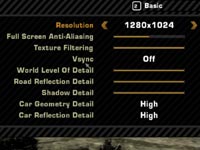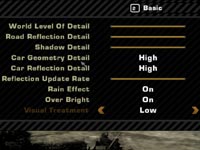Need For Speed: Most Wanted:
Publisher: Electronic ArtsWe used the full retail version of Need For Speed: Most Wanted - the latest addition to Electronic Arts' popular Need For Speed franchise. The game makes use of shaders everywhere, with realistic car reflections, a dynamic sky making use of HDR bloom and also weather patterns that change during the game. Most of the game takes place in the daytime, so aliasing is much more noticeable than it was in previous versions of the Need For Speed: Underground sub-franchise - antialiasing is preferred over a higher resolution in order to combat the edge aliasing.
There is a new setting called Visual Treatment which - when set to high - leaves a bright glow on most objects that get in the way of the sunlight. We feel this looks slightly unrealistic as the effect is over-used to an extent and it's best left set to the low setting with overbright enabled. Along with this, there's also the fact that the high setting causes a big performance drop, giving yet another arguement for leaving it on the lower setting.
We found that the best playable settings in this game were when the average frame rate was above 40 frames per second, while the minimum was around 25 frames per second and the majority of the frames were rendered above 30 fps. We did three manual run throughs of the Diamond & Union sprint track using the Lamborghini Gallardo against three opponents with moderate levels of traffic.


This was a whole resolution higher than what we found to be playable on the Radeon X850XT. ATI's flagship AGP card delivered a smooth gaming experience at 1024x768 2xAA 16xAF with some of the details turned down to allow for acceptable performance. We had to lower the world detail along with road reflections and car reflections down a notch in the advanced settings menu in order to keep our minimum frame rate high enough to be accepable.
There was literally no contest in this title, with the BFG Tech GeForce 7800 GS OC providing a considerably better gaming experience. Not only were we able to increase the resolution, we were also able to increase the in-game details and add 2x transparency multisampled antialiasing into the fray too.

MSI MPG Velox 100R Chassis Review
October 14 2021 | 15:04









Want to comment? Please log in.